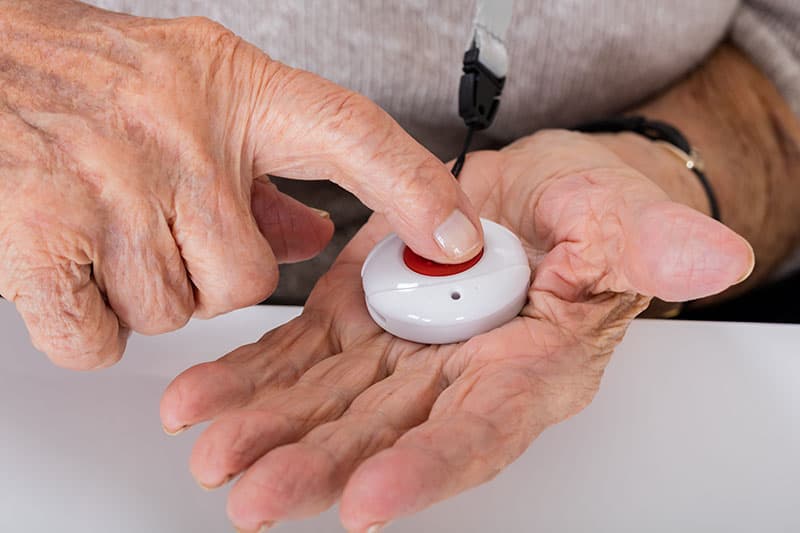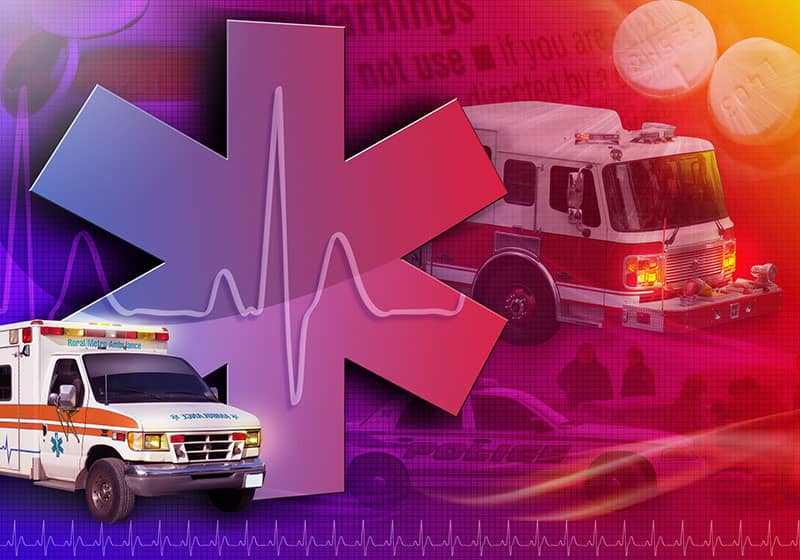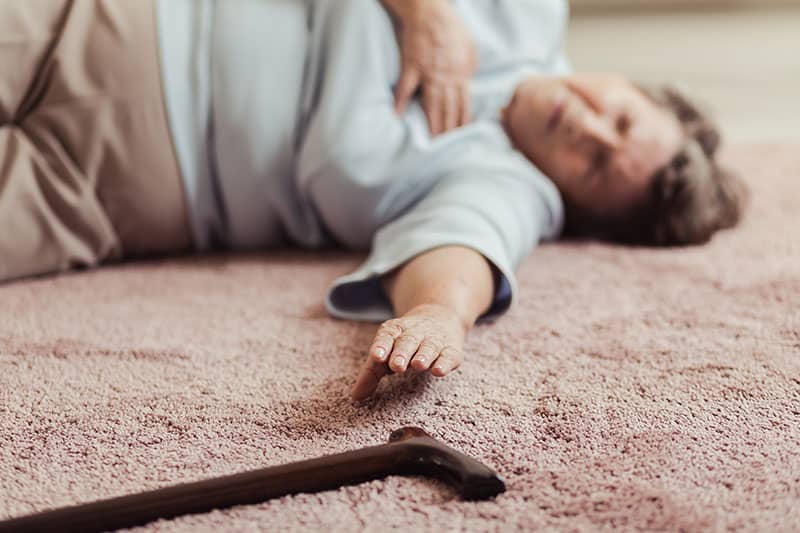
A medical alert system is a device that provides users with a convenient and reliable way to notify a monitoring center or a caregiver in the event of a health or personal emergency.
Medical alert devices are wearable and come in the form of a pendant, bracelet, watch, or clip. Monitored systems may have an initial set-up cost and ongoing monthly fees which vary depending on the company provider.
Why do seniors in Alberta need a medical alert system?
Seniors face many risks and challenges to their health and safety. Falls, for instance, account for many cases of injuries, and even death, among the elderly. It is critical that any person receives immediate medical assistance after a fall, especially when there are injuries or bleeding.
Calling for emergency assistance can be difficult if a senior is living alone.
With a medical alert system with fall detection, an alert can be automatically sent to a monitoring center even if the person falls unconscious after falling.
As you can see, a medical alert system can be a real life-saver during emergencies. Thus, seniors in Alberta need to be equipped with a reliable device for their personal safety and health.
No matter where you are in Alberta, our partner medical alert system companies can offer you the right device within your budget!
Just fill out the form on this page to receive FREE and NO-OBLIGATION quotes.
How do medical alert systems for seniors work?

Medical alert systems can be challenging for seniors to understand, especially if using for the first time.
There are key differences in the many medical alert systems available on the market – monitored and unmonitored systems, at-home systems and mobile systems, with automatic fall detection, GPS tracking, etc.
Hence, the variety of options can be overwhelming. We want to help you find the right system for your needs by explaining in detail how medical alert systems for seniors work.
Components of a medical alert system
Medical alert systems have 2 parts – the device (panic button) and the 24-7 monitoring service.
Systems for home use have a base unit (console) while mobile systems don’t generally have one. The console is plugged in your home and connects to your wearable device.
The panic or help button is worn on the neck or wrist or clipped to a belt. It communicates with the console. Depending on the type of plan you choose, your device can include additional features such as medication reminder, GPS tracking, fall detection, etc.
Medical alert systems also feature a voice communication system that allows you to speak to a trained emergency agent using your console or device.
Installing the medical alert system
Providers aim to make the system easy to use. Installation usually involves plugging the console into an electrical outlet and checking that the panic button works. Most companies offer self-installation and customer support. Some provides charge a one-time activation fee.
Professional Monitoring Services
The second important component of a medical alert system is the monitoring services. Upon pressing the help button, a user will be connected quickly (20 to 30 seconds on average) to a trained agent at the monitoring center. A user can press the panic button in a medical emergency, to summon the police, or in case of fire.
A senior can also ask for assistance in non-medical emergencies such as needing to contact a relative to assist.
Some systems have automatic fall detection which alerts the monitoring center if the user falls. Built-in sensors can detect a fall and send an alert so that emergency services can be dispatched quickly.
Monitoring services have an ongoing monthly charge. Some providers don’t require a long term contract while other companies do.
Can you get an unmonitored medical alert system to save money? Yes, you can, but remember that the response to your emergency depends on the availability of the person/s receiving the alert.
If your panic button sends the alert to a family member who is not always available, a response to your emergency is not guaranteed. These unmonitored systems also don’t offer any support if you encounter problems with your device.
Types of medical alert systems
Medical alert systems can be at-home or mobile systems.
Systems dedicated for home use are suitable for adults with mobility issues, chronic diseases, balance issues, recovering from surgery or injury, or with disabilities.
These systems can use landline or cellular connections. For seniors who want to extend their independence, at-home medical alert systems are essential.
In any emergency, the user needs to press the help button to connect to a monitoring center to ask for assistance. Caregivers or contacts on a pre-established list can also be notified of an emergency.
This means that a senior living alone can easily and quickly get help without having to dial a landline or mobile phone.
In contrast, seniors with more active lifestyles can choose the more sophisticated mobile systems. These devices use cellular networks and offer protection even while on the go. Features such as fall detection and GPS tracking enhance the user’s protection. Seniors with dementia or Alzheimer’s will benefit from GPS tracking so they can be quickly located if they wander or become disoriented.
Regardless of how often you go outside your home, mobile medical alert systems will offer an easy and convenient way to ask for help in any emergency.
Using a medical alert system
When a user presses the help button on the at-home medical alert system using the console or the pendant, a staff from the monitoring center will receive the user’s location and information. With two-way communication, you can speak to a professional agent directly who will send help based on your type of emergency.
The response time is in seconds, not minutes, and emergency responders can arrive at your home as quickly as possible to lend a hand.
Is a panic button only for medical emergencies? Not at all. Do you feel unwell? Do you think an intruder is trying to break into your house? Did you fall and can’t get up? Are you lost and can’t find your way? Have you locked yourself in the bathroom or need help getting dressed? You can use your help button to call for help in any type of situation that threatens your safety, health, or well-being.
If the situation requires a family member to be contacted, the monitoring center will get in touch with your listed kin or contact person.
This is why medical alert systems are also referred to as personal emergency response systems (PERS).
It is important to understand that you need to press the panic button to receive emergency assistance. It is recommended that you get a waterproof device that can be worn even in the bath for non-stop protection.
Do you need fall detection?

Fall detection technology can be built into your medical alert system so that someone is alerted in case of a fall. Sensors, also called accelerometers, detect unusual motion when you fall and notifies the monitoring center that you may be in distress. Most companies offer automatic fall detection as an additional feature with an extra charge monthly.
These fall detection devices have sensors in the GPS-enabled mobile device that can be worn as a watch or pendant. Studies show that pendants or panic buttons worn around the neck are more accurate in terms of fall detection because movements with the hand such as waving can lead to false alerts.
How accurate is fall detection technology?
Ambient sensors and algorithms have about 85 to 93% accuracy for fall detection. While it isn’t 100%, it is quite close.
If your fall detection device sends out a notification, the monitoring center staff will try to contact you to find out what happened. If you can speak, you can provide details so they know exactly how to help you. If you cannot speak, the monitoring center staff will send emergency assistance.
In case of a false alert or if you don’t need help, you can tell the monitoring center that everything is fine and the alert will be disregarded. You can also cancel an alert by pressing the panic button twice.
In any case, having someone notified quickly after a fall is worth it despite the possibility of false alerts. For seniors, quick response in a health emergency is vital and can mean life or death.
Who should use a medical alert system?

The Center for Disease Control and Prevention report that more than 1 in every 4 older adults fall every year. The Public Health Agency of Canada says that falls are the leading cause of injury, particularly hip fractures, among Canadian seniors. It is significant to note that 30% of seniors were subsequently admitted to long-term care after hospitalization due to a fall.
Deaths resulting from falls also rose to 65% from 2003 to 2008.
Fortunately, falls can be prevented and precautions can be put in place to protect seniors from the serious effects of elderly falls.
Medical alert systems with fall detection are recommended for:
- Elderly people living alone;
- Seniors aged 70 and over;
- Patients suffering from heart conditions or stroke;
- Patients with chronic diseases, no matter what age;
- Seniors with mobility or balance problems;
- Those taking medications with side effects such as disorientation, dizziness, nausea, etc.
- Individuals with a history of falls;
- People who have asthma, seizures, dementia, Alzheimer’s, etc.
Using a medical alert system with fall detection can save your life and provide peace of mind to you and people who care about you.
Compare top medical alert systems with fall detection in Calgary, Grand Prairie, Edmonton, Red Deer, Lethbridge, and anywhere in Alberta using our short online form!
What fall detection systems are popular in Alberta?
Medical emergencies happen without any warning. That’s what makes them scary and dangerous.
Family members or friends may not be around when such emergencies occur.
Seniors will feel safer and confident knowing that they can always get help with just a press of a button.
What are the top medical alert systems for seniors in Alberta? Allow us to show you in the list below.
Lifeline
Lifeline is dedicated to seniors. Their systems offer at-home, fall detection, GPS, and wireless systems. The company also boasts of Canadian and company-owned monitoring centres. The equipment is free and no long-term contract is required.
This company offers the widest range of medical alert systems to suit all types of budgets and needs with their HomeSafe (landline), HomeSafe (wireless), HomeSafe (AutoAlert Landline), Wireless with fall detection, and GoSafe Mobile System.
Their devices are water-resistant but not waterproof.
Monthly Fees: $29.95 (HomeSafe basic) to $56.95 (HomeSafe Autoalert Cellular)
Life Assure
Based in Winnipeg, Manitoba, this company offers personal emergency response systems for seniors.
Adults can access help with their panic button 24/7 connected to reliable monitoring centers.
The company offers the Classic home that works with a landine and the Premium Mobile Plus. Fall detection can be added with an additional charge.
Their systems can work using VOIP/cable instead of the regular landline and no long-term contract is required. The equipment is also free of charge.
Their devices are water-resistant but not waterproof.
Monthly Fees: $29.95 (Classic Home) to $49.95 (Premium Mobile Plus).
Telus Livingwell Companion
This medical alert system from Telus offers Companion Home for home use and Companion Go for mobile services. Fall detection can be added as an additional service. When an alert is received by their monitoring center, up to 3 family members or contacts are notified. If nobody is available, emergency services will be contacted when necessary.
No landline is required and the equipment is included in the monthly fees. No long-term contract is required.
The pendants for Telus are bigger compared to other systems. Their devices are water-resistant.
Monthly Fees: Plans start at $25 a month.
Global Security
Global Security, a well-established security company in Canada, offers personal emergency response systems to seniors with their Numera Libris from Nortek.
They claim to have the most accurate fall detection technology and offers a platform called EverThere for health management.
This company also offers ADT security systems and has partnerships with ULC-qualified monitoring centres.
Their devices come in the form of a bracelet or a pendant and are water-resistant.
Fees: The basic package costs $34.99 (36-month contract). The GSM package (limited offer) costs $379.95 + $99.00 activation + $79.00 for the panic button.
Red Dot Personal Alert Solution
Based in Ottawa, this personal alert system was created by experts in elderly care. The company offers 3 services – At-home (basic), At-home (with fall detection), and On-the-Go.
Help calls are answered by monitoring centres in Canada by bilingual operators and certified by the Underwriters Laboratories of Canada (ULC).
Landline is required for at-home plans and their On-the-Go system works with mobile service coverage.
The equipment must be purchased plus a monthly monitoring fee.
Fees: Their At-Home Plan costs $39.99 while the On-The-Go Plan costs $59.99.
How do I choose the best medical alert system?

Now that you know the basic features and function of medical alert systems, it is time to assess which system meets your needs.
Several medical alert companies offer panic buttons in Alberta for a monthly cost but they are not equal in quality.
If you have a friend who uses a medical alert system, you can always ask for tips or referrals. But keep in mind that people are in different situations and have different needs. You must base your choice on your own lifestyle, preferences, and budget.
The best way to do this is to compare top medical alert systems in Alberta with free and no-obligation quotes from our partner companies.
Fill out the short online form below and receive offers tailored to your needs and budget.
Get peace of mind with your panic button with fall detection today!


